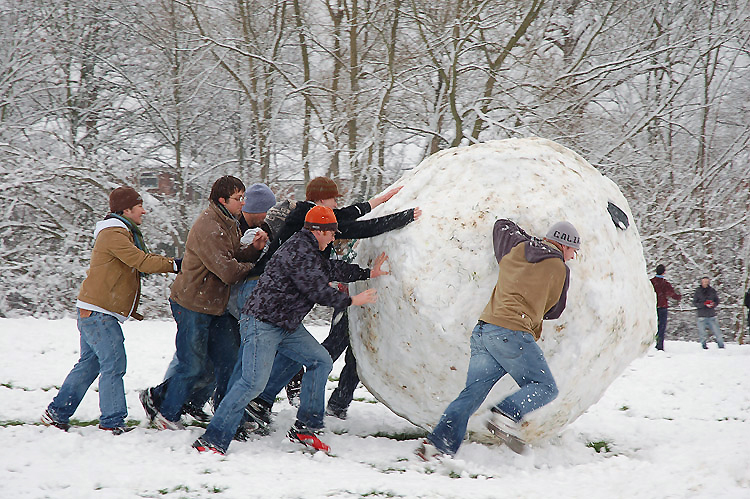 Giant snowball created by Oxford students. Courtesy photo
Giant snowball created by Oxford students. Courtesy photo
AGU News:
Glaciation events during the Neoproterozoic (524-to-1,000 million years ago) and Paleoproterozoic (1,600-to-2,500 million years ago) periods – events that
spawned ice ages that persisted for millions of years at a time – may have seen glacier ice encircle the planet in a frosty planetary configuration known as a
Snowball Earth.
Whether the planet could have existed in such a state, however, is a matter of considerable debate.
An elevated planetary albedo, caused by the planet being covered in reflective snow and ice, would mean that a Snowball Earth would reinforce itself.
With no known mechanisms able to fully explain how the planet could have thawed out from such a state, some scientists suspect that Snowball Earth never happened.
However, using a series of global general circulation models, Abbot et al. find that the greenhouse potential of clouds, which had been overlooked in previous research, could explain how a Snowball
Earth may have melted.
Previous modeling research found that to thaw out a glacier that covered the planet would require carbon dioxide to account for up to 20 percent of the atmosphere by volume.
Paleogeochemical evidence, however, shows that carbon dioxide levels reached only 1 percent to 10 percent.
The model used for the earlier research, the authors find, ignored the warming potential of clouds.
Clouds not only trap infrared radiation near Earth’s surface, warming the planet, but also reflect incoming sunlight, cooling the planet.
In the modern climate, both effects are important. However, set against a planet encompassed in ice, clouds’ reflectivity becomes less important, and the overall effect of clouds is to warm the
planet.
By accounting for the heat-trapping effects of clouds, the authors find that the atmospheric carbon dioxide concentration required to drive deglaciation is 10-100 times lower than previous research suggested, a concentration that fits within observed levels.
Source:
Geophysical Research Letters, doi: 10.1029/2012GL052861, 2012
http://dx.doi.org/10.1029/2012GL052861
Title:
Clouds and Snowball Earth deglaciation
Authors:
Dorian S. Abbot, Raymond T. Pierrehumbert, and Daniel D. B. Koll: Department
of Geophysical Sciences, University of Chicago, Chicago Illinois, USA;
Aiko Voigt: Max Planck Institute for Meteorology, Hamburg, Germany;
Mark Branson: Department of Atmospheric Science, Colorado State University,
Fort Collins, Colorado, USA;
David Pollard: Earth and Environmental Systems Institute, College of Earth and
Mineral Sciences, Pennsylvania State University, University Park, Pennsylvania,
USA;
Guillaume Le Hir: Institut de Physique du Globe de Paris, Universite Paris 7-
Denis Diderot, Paris, France.

